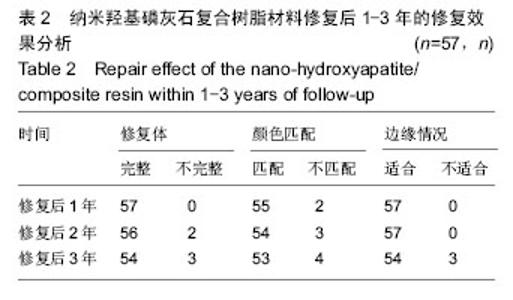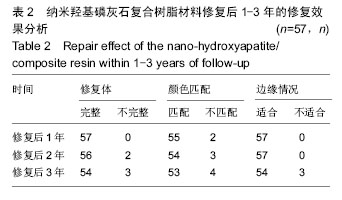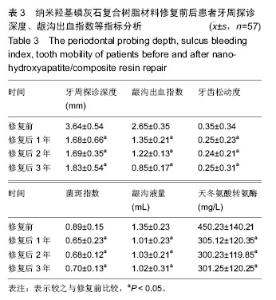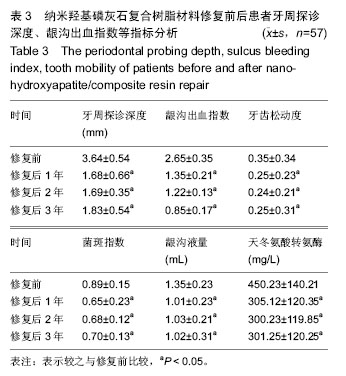| [1]鲁红,吴织芬,田宇,等.一种新型纳米羟基磷灰石材料应用于牙周组织工程的可行性研究[J].牙体牙髓牙周病学杂志,2005,15(1):6-9.
[2]鲁红,吴织芬,田宇,等.应用细胞-支架构建方式的组织工程方法促进牙周组织再生的实验研究[J].牙体牙髓牙周病学杂志,2005,15(1):14-18.
[3]王健平,周立波,岳红霞,等.氟纳米羟基磷灰石封闭人离体牙牙本质小管的生物相容性[J].中国组织工程研究,2012, 16(16):2951-2954.
[4]邢晓艳,张青松.纳米羟基磷灰石在口腔医学中的应用[J].继续医学教育,2013,27(10):54-55.
[5]Perrier-Groult E,Pasdeloup M,Malbouyres M,et al. Control of collagen production in mouse chondrocytes by using a combination of bone morphogenetic protein-2 and small interfering RNA targeting col1a1 for hydrogel-based tissue-engineered cartilage.Tissue Eng Part C Methods.2013;19(8):652-664.
[6]王云,王青山.牙体修复性纳米羟基磷灰石复合材料的机械性能研究[J].现代口腔医学杂志,2011,25(2):115-117.
[7]陈芳,叶眉,姜大川,等.脂肪干细胞矿化中富血小板血浆的诱导作用及其在支架上附着增殖的研究[J].牙体牙髓牙周病学杂志,2009,19(1):11-15.
[8]赵征.大鼠牙源性细胞复合Nhac/PLA形成牙体组织-骨复合体样结构及ADAM28基因作用的研究[D].军医进修学院,2010.
[9]李瑞,王青山,王云,等.四甲基偶氮唑盐法评价牙体修复性纳米羟基磷灰石复合材料的体外细胞毒性[J].中国组织工程研究,2012,16(34):6321-6325.
[10]韩纪梅,李玉宝,梁新杰,等.纳米羟基磷灰石与牙无机质的比较研究[J].功能材料,2005,36(7):1069-1071.
[11]鲁红,吴织芬,田宇,等.应用生长因子-支架构建方式的组织工程方法再生牙周组织的实验研究[J].牙体牙髓牙周病学杂志,2005,15(1):10-13.
[12]Jaiswal AK,Chandra V,Bhonde RR,et al.Mineralization of nanohydroxyapatite on electrospun poly(L-lactic acid)/ gelatin by an alternate soaking process: A biomimetic scaffold for bone regeneration.J Bioact Compat Pol.2012;27(4):356-374.
[13]Browning WD,Cho SD,Deschepper EJ,et al.Effect of a nano-hydroxyapatite paste on bleaching-related tooth sensitivity.J Esthet Restor Dent.2012;24(4):268-276.
[14]Zelic K,Milovanovic P,Rakocevic Z,et al. Nano-structural and compositional basis of devitalized tooth fragility.Dent Mater. 2014;30(5):476-486.
[15]冯瑶,冯思聪,王建平,等.玻璃离子水门汀加入改良纳米羟基磷灰石后的性能[J].中国组织工程研究, 2013,17(42): 7382-7388.
[16]孙卫斌,吴亚菲,丁一,等.纳米羟基磷灰石诱导人牙周膜细胞碱性磷酸酶表达的研究[J].中华口腔医学杂志, 2006, 41(6):348-349.
[17]Qian X,Yuan F,Zhimin Z,et al.Dynamic perfusion bioreactor system for 3D culture of rat bone marrow mesenchymal stem cells on nanohydroxyapatite/polyamide 66 scaffold in vitro.J Biomed Mater Res B Appl Biomater.2013;101B(6): 893-901.
[18]李平,肖丽英,李伟,等.新型纳米羟基磷灰石(n-HA)糊剂封闭根尖性能及其对病原菌抗菌活性的体外实验[J].牙体牙髓牙周病学杂志,2007,17(4):214-218.
[19]Park Y,Kim JH,Hwang KS,et al.Research about Tooth Whitening and Bacteria Sticking Capability with Using Dentifrice Including Nano-Hydroxyapatite, Sodium Metaphosphate.Key Eng Mater. 2007;330/332(1): 283-286.
[20]韦纪英,何霞,贺于奇,等.PRP复合纳米羟基磷灰石对兔牙槽骨缺损的修复作用[J].广东医学, 2009,30(12): 1786-1788.
[21]潘超,黄强,李金娥,等.抗龋生物活性材料-纳米羟基磷灰石性质及在口腔中应用[C].//2005年中国口腔清洁护理用品工业学术研讨会论文集,2005:141-144.
[22]吴晓楠,苗雷英,刘玉,等.电纺聚己内酯/Ⅰ型胶原蛋白/纳米羟基磷灰石复合材料的制备及其生物相容性研究[J].口腔医学,2015,35(4):245-249.
[23]王云,王青山.纳米羟基磷灰石及其复合材料在口腔医学中的应用[J].中国组织工程研究与临床康复, 2010, 14(8):1426-1428.
[24]Park Y,Kim JH,Hwang KS.Research about Tooth Whitening and Bacteria Sticking Capability with Using Dentifrice Including Nano-Hydroxyapatite, Sodium Metaphosphate//Bioceramics.2007;19(1):283-286.
[25]Tam L.Commentary.Effect of a nano-hydroxyapatite paste on bleaching-related tooth sensitivity.J Esthet Restor Dent.2012;24(4):277.
[26]Kim BI,Jeong SH,Jang SO,et al.Tooth Whitening Effect of Toothpastes Containing Nano-Hydroxyapatite.Key Eng Mater.2006;309/311(1):541-544.
[27]Zheng J,Li Y,Shi MY,et al.Microtribological behaviour of human tooth enamel and artificial hydroxyapatite.Tribol Int.2013;63:177-185.
[28]李平,肖丽英,李伟,等.新型纳米羟基磷灰石根充糊剂的细胞毒性研究[J].华西口腔医学杂志,2005,23(5):427-430.
[29]张艺君,尹路,张翼,等.掺钾纳米羟基磷灰石脱敏材料对ZPCC与牙本质粘结强度的影响[J].牙体牙髓牙周病学杂志,2015,25(10):596-601.
[30]方厂云,曹莹,夏宇,等.大鼠牙乳头细胞与纳米羟基磷灰石的体外复合培养[J].中南大学学报(医学版), 2007,32(1): 114-118.
[31]刘冰,陈鹏,臧晓霞,等.活性纳米羟基磷灰石复合胶原/聚乳酸材料对拔牙创早期愈合及牙槽嵴吸收影响的实验研究[J].口腔医学,2010,30(1):38-41.
[32]鲁红,吴织芬,田宇,等.异体脱矿松质骨基质和纳米羟基磷灰石材料应用于牙周组织工程中的可行性探讨[J].中国临床康复,2002,6(17):2538-2539.
[33]Sanosh KP,Chu MC,Balakrishnan A,et al.Synthesis of nano hydroxyapatite powder that simulate teeth particle morphology and composition.Curr Appl Phys. 2009;9(6):1459-1462.
[34]Hwang JM,Kang JO,Park Y,et al.Research about bovine teeth brightness with using dentifrice slurry including nano-hydroxyapatite//2010 3rd International Conference on Biomedical Engineering and Informatics. v.5.2010:1958-1960.
[35]vanManen EHC,Zhang W,Walboomers XF,et al.The influence of electrospun fibre scaffold orientation and nano-hydroxyapatite content on the development of tooth bud stem cells in vitro.Odontology. 2014;102(1): 14-21.
[36]王健平,王本材,贾鑫,等.纳米羟基磷灰石和氢氧化钙对成牙本质细胞活性影响的比较[J].中国组织工程研究, 2012, 16(3):417-420.
[37]杨清岭,李宝花,尹蒙熔,等.纳米羟基磷灰石和纳米羟基磷灰石/聚酰胺66直接盖髓术的组织学对比观察[J].黑龙江医药科学,2010,33(3):27-28.
[38]富建明,苗波,贾刘合,等.纳米羟基磷灰石修复兔颌骨缺损的组织学分析[J].中国组织工程研究与临床康复, 2008, 12(1):157-160.
[39]刘冰.纳米羟基磷灰石复合胶原/聚乳酸材料提高义齿修复效果的基础实验研究[D].第四军医大学,2006.
[40]赵刚,尹蒙熔,李德超,等.纳米羟基磷灰石修复牙槽骨缺损后正畸牙齿移动的可行性研究[J].黑龙江医药科学, 2010, 33(3):10-11. |





